
If you enjoy reading this article, why not check out our articles on The Top 10 Strongest Bugs – This surprised me! and How Strong Are Ants? Let’s Find Out!
Bugs Pets – Which One Is Right For You?
If you are trying to look for a pet and the normal choices are not the right fit for you, you might be interested in having a pet bug.
There is a lot to choose from. From tiny insects like ants to big arthropods like centipedes and everything in between. Not sure where to start? Read through our list below and see what strikes your fancy.
How to Choose Your Pet Bug?
Extensive research needs to be done when you are adopting a bug. It might not seem like a lot of work, but there are a lot of things you need to learn to take good care of it.
Even if they are not mammals or reptiles, like dogs or turtles, bugs are still living creatures and need to be respected. Do not think having a pet bug is an easy task and then let it die in a burst of negligence.
That being said, there are bugs that are really low maintenance as pets, but others will need a lot of care and special conditions. So just make sure to know what you are getting into.
Bear in mind there are a lot of bugs that have social lives – even though most people don’t know or don’t believe it – and they need to be in the company of others of their same species. Other bugs are extremely solitary and need time alone, even away from you. You must choose wisely when you decide to adopt a bug as a pet.You should also keep in mind there are a lot of laws and regulations concerning bugs. Whether it’s because they are venomous creatures, considered a pest or can disrupt an otherwise undisturbed ecosystem, each bug has a distinct background that needs to be studied before bringing one home.
Insects That Make Great Pets:
There are a lot of options, some are children friendly, others are more dangerous and exotic and a few of them can be left alone for a long time. Choose your best ally!
| Bugs | Life span | Species | Happy Temperature |
| Spiders | up to 3+ years | 35,000 species of spiders | up to about 80 degrees F. |
| Tarantulas | up to 3+ years | 800 documented species | up to about 85 degrees F. |
| Stick Insects | 5 to 12 months | nearly 3,000 species | 25°C |
| Leaf insects | twelve months | more than 50 species | between 25 °C and 30 °C. |
| Praying Mantis | around 1 year | about 1,800 species | about 75-80 degrees F. |
| Grasshopper | live five to 10 days | over 11,000 species | 86-112°F (30-44°C). |
| Crickets | 2 to 3 months as larvae, 3 weeks as an adult | around 900 species | between 80-85° F. |
| Beetles | 3 to 6 months | 250,000 described species | warmer |
| Hissing cockroaches | five years | 20 known species | 75 to 90 degrees Fahrenheit. |
| Millipedes | up to 10 years | 12,000 different species | 75 to 80 degrees Fahrenheit |
| Centipedes | as long as six years | 8,000 species | 80 degrees |
| Scorpions | 2-6 years | 2,000 species | 68 to 99 °F |
| Mealworms | over two years | 20,000 | 65-100 F |
| Ant | 1 to 3 years | 12,000 species | 75-95 degrees Fahrenheit |
#1 Spiders
Nature of bug
Ok, spiders are technically neither bugs nor insects, but they do make great pets. Spiders can be very interesting to observe, and they don’t require too much care or fancy equipment in order to keep them happy.
Although people are often scared of spiders, if you really think about it, most of the time they are more like friends. Spiders of different kinds live all around us, and many of them help us by dealing with small pests like mosquitoes.
There are thousands of different species of spiders living all around the world. While exotic spiders can often be purchased, this is not necessary in order to start keeping spiders as pets. For a start, you can simply find and capture a local spider species that lives in your surroundings.
Housing features
You don’t really need fancy equipment in order to take care of a pet spider. A little jar or a box with enough holes that let the spider breathe will do the job.
Wherever you place your pet spider, remember to keep it sealed and with no places where the spider can escape. These little eight-legged arthropods are escape artists and won’t hesitate to leave.
Feeding
In order to survive in captivity, your pet spider will need access to food and water. The water part is easy – simply live a bit of water in a small container lying around.
Since spiders are predatory arachnids, they need to feed on other, smaller insects. Most spider owners prefer to handle little insects, like crickets.
Love and care
Once you have taken care of everything, you need to understand most spiders aren’t social and it’s best to leave them alone.
They will spend their time eating, wandering around or making spiderwebs.
Keep in mind, there are a lot of venomous spiders out there. You might want to stay away from those, or at least be very careful when handling them.
If you want more information about having spiders as pets, check out our article The Three Best Kinds of Spiders to Keep as Pets.
#2 Tarantulas
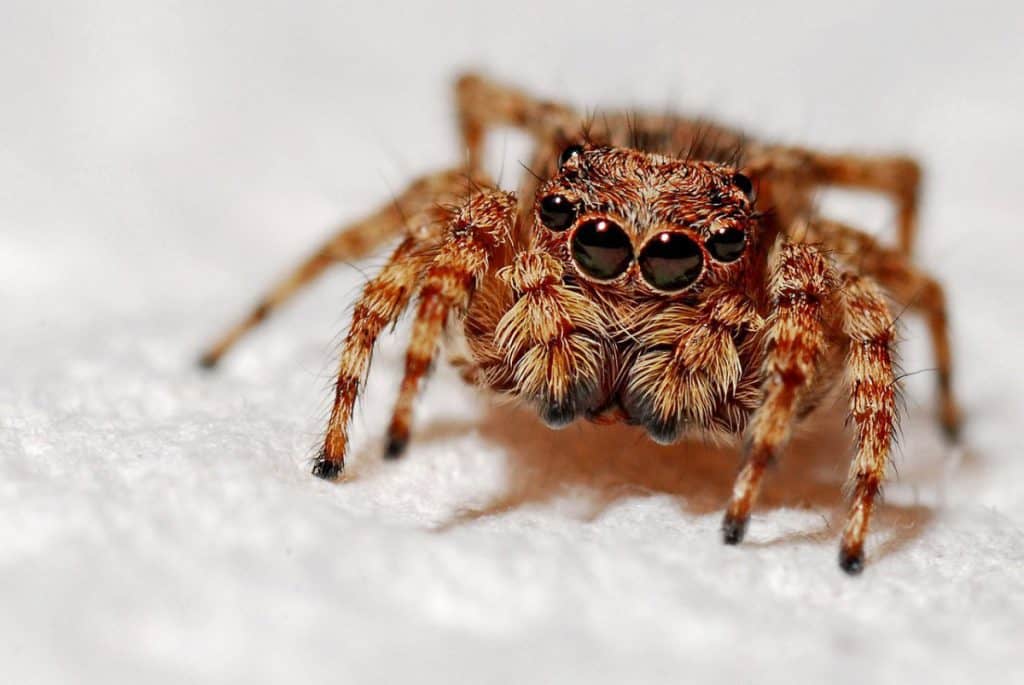
Nature of bug
Tarantulas are the spiders’ big brother. Technically, tarantulas are spiders as well. But most people separate the two into different categories. Antd quite frankly, keeping a tarantula is a whole different experience than keeping a regular spider.
Tarantulas are bigger than most other spiders. Almost all of them are venomous, but, contrary to popular belief, most of them aren’t dangerous to humans.
There are more than 850 different species of tarantulas, and most of them live in warmer, tropical regions. If you live in such a region (such as South America), tarantulas in the wild are quite common and you could easily capture one. In other parts of the world, it’s more common to buy these spiders from specialized stores.
Housing features
Tarantulas are fairly large, so they will need a larger container to live in, such as an aquarium. These spiders prefer to live away from noise and too much light. They need to have space to move around and behave as they normally would inside their enclosure, and that includes hiding spaces also.
Feeding
Tarantulas are carnivores and they need to be fed live insects. These can be captured in the wild or bought from a pet store. Tarantulas will eat almost any kind of insect, including crickets, mealworms, and cockroaches. They can even eat tiny rodents, like mice.
Love and care
Tarantulas need the same care as spiders do: They are not social, so you don’t need or have to handle them periodically and are best alone in their cage.
Even though spiders can be as dangerous as tarantulas, it’s more common for tarantulas to be poisonous or aggressive towards humans, as they are afraid of us due to our size.
Tarantulas need to be handled with care, as dropping them can provoke their abdomen to burst, fatally wounding the arachnid.
If taken care of properly, most tarantulas can live for more than two decades.
If you’re worried about the dangers of having a pet tarantula, you may want to peruse our article Do Pet Tarantulas Bite? Yes and No.
#3 Stick Insects
Nature of bug
One of the most popular options when it comes to pet bugs. They are extremely easy to care for and extremely fragile as well. If you have captured a stick insect, there is not much you should do to keep it happy and healthy.
There are many different kinds of stick insects and they vary a lot in looks and size. While the smallest ones are only about half inch long, the largest known stick insects (Phobaeticus kirbyi from Borneo) is over 21 inches long if one measures it with its legs stretched out. Then there is everything in between.
Housing features
Stick insects need an enclosure three times as tall as they are long. It should also be two times as wide as the stick insect is long, but the height parameter is actually more important.
Here is why the enclosure needs to be so tall: stick insects like to (or rather need to) hang upside down when molting. Not providing enough vertical space for that may result in a deformed or dead stick bug.
In order to hang upside down, the stick insect does need to hold onto something (they can’t hold on to glass). For this reason, the top of the cage needs to be made of fine wire mesh or a similar material. The rest of the walls can be made of any material you like or, rather, have laying around. Just as long as its transparent so you can actually see your pet.
Feeding
Naturally, stick bugs also need water and food to live. The water needs to be in a sealed recipient, so the little bugs don’t fall into it and drown.
The cool thing about these insects is that they aren’t carnivores. In other words, they are happy to munch on plants all their life. To feed them, you need to give them thing like berries or fresh lettuce once per week.
Love and care
Stick insects don’t mind being handled by humans, but if you decide to do it, you need to be tremendously gentle. You should never grab them by their extremities, only by their body. And it’s preferable you don’t grab them at all and instead use your palm to push them around.
#4 Leaf Insects
Nature of bug
Leaf insects are almost identical to stick insects, the only main difference is leaf insects have adapted to camouflage using their body structure that looks similar to a leaf. These two insects are incredibly similar and require almost identical care, with a few caveats.
Housing features
The rules for choosing an enclosure for leaf insects are similar to those for stick insects: three times as big as their bodies.
Feeding
Leaf insects can live off berries and leaves like stick insects. But if you have a young leaf insect, you need to break off the food into little pieces, as young nymphs can’t eat unbroken leaves.
Love and care
Leaf insects need to be handled as gently as a stick insect. Unfortunately, they have a short lifespan and cannot live for longer than 18 months, just like stick insects.
You should also be aware that even though female leaf insects cannot fly, their male counterparts can. You should probably leave any male leaf insect inside their enclosure unless you want to risk them flying away.
#5 Praying Mantis

Nature of bug
A praying mantis can be a tricky pet to have. They need a special enclosure, a diverse diet and there are times where you can’t touch it. Still, they are one of the most interesting insect pets you can have.
There are more than 2000 species of praying mantis in the world, and they come in a variety of fascinating shapes and colors. Exotic mantis species look fascinating, but for beginners it’s usually best to start with a species native to the area where you live. No matter if you buy them from a store or catch in the wild, local mantis are easier to care for than exotic species.
Housing features
A praying mantis cage is the most important and difficult thing to accomplish. It needs to be three times as large and twice as wide as the insect. If you make the enclosure smaller than that, the praying mantis will be stressed out. If the enclosure is too big, the praying mantis will have a hard time hunting their prey and can starve.
The floor needs to be a mixture of soil and sand so it can keep moisture. There need to be twigs on top of the cage so the praying mantis can hang when it’s molting.
Feeding
The praying mantis is a carnivore predator and feeds off other insects and small rodents. You need to feed your praying mantis healthy insects or it can get sick. You should also have a different set of insects to feed the praying mantis, as it needs a diverse diet to fulfill its nutritional requirements. If you feed it right, your praying mantis can live between six months up to a year.
Love and care
Praying mantis are some of the most popular pets from the world of bugs. They aren’t dangerous and they can get used to humans. Some will even learn to crawl on your hand. Still, a praying mantis is a fragile creature and should always be handled gently and with utmost care.
Keep in mind that, typically, multiple praying mantis can’t live together in the same enclosure. If your praying mantis has offspring, you need to separate them immediately, as they can start eating each other.
Also, be aware that you cannot touch the praying mantis when it’s molting, because it lacks an exoskeleton and it’s extremely fragile.
If you are interested in keeping a praying mantis as a pet, check out our Beginners Guide to Keeping Praying Mantis as a Pet for more info!
#6 Grasshopper
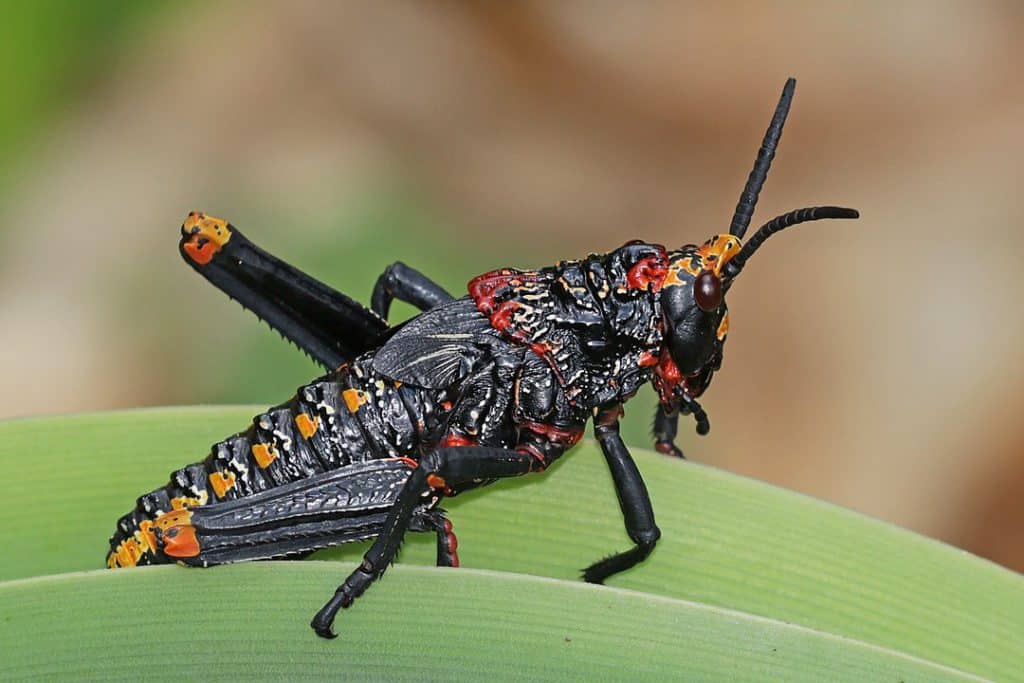
Nature of bug
Even though they do not have very long lives (only about a year, maximum), you can have a grasshopper to keep you company for a couple of months.
Housing features
You’ll need a big enclosure for a grasshopper and one that is sealed to avoid any unwanted escapes. You need to let air flow freely into the cage to avoid asphyxiating your pet bug.
To make your grasshopper feel at home, you’ll also need to cover the floor of the enclosure with something that feels natural. Materials commonly used include sand, oatmeal, and coconut substrate.
Place a few twigs inside as well for the grasshopper to sit on. You should place the cage below a source of light. But you should avoid sunlight as it can heat the cage more than necessary.
Feeding
Feeding grasshoppers is incredibly easy. They are herbivores. You can leave a couple of grass leaves in their cage and they will eat it until they are satisfied. You should remove any old leaves as they can get too dry and impossible to eat.
Beware of insecticides, if the grass you give your grasshopper is laced with poison, it can kill the bug. Leave the water for the bug to drink as well and change it daily.
Love and care
Beware of capturing or releasing grasshoppers. Some species are endangered and others can become pests overnight. As for the love, it’s best to adore your grasshopper from the outside and not really touch it.
#7 Crickets
Nature of bug
Having a pet cricket is not a new idea. Ancient Chinese civilizations used to do it as early as twelve century AD. You can capture a cricket or buy them in bulk, but beware two things: One, they have an extremely short lifespan: One to two months. And second, male crickets make a lot of noise, you need to be ready to be able to handle it.
Housing features
Having a pet cricket isn’t hard at all. You can have them in small plastic containers with holes for them to breathe.
Feeding
You should leave two small containers, like two bottle caps. One filled with water and the other filled with food.
Crickets need both greens and meat – they are omnivores. The easiest way to feed them is to buy a special food mix made for crickets, but it’s also easy to prepare the food yourself.
Leave them a few greens and a little bit of dog or cat food, and crickets should be happy. If they lack meat, crickets will start to eat each other.
Love and care
Crickets are cute and fascinating to watch, but it’s best to keep them in their enclosure all the time. Except when you are cleaning it, which should be done occasionally.
If you have female crickets, you need another bottle cap filled with dirt. The female cricket will use it to plant her eggs. If the eggs end up hatching inside your enclosure, be aware that you’ll suddenly have hundreds of tiny crickets on your hands, so have a plan for that if you decide to keep the eggs.
#8 Beetles
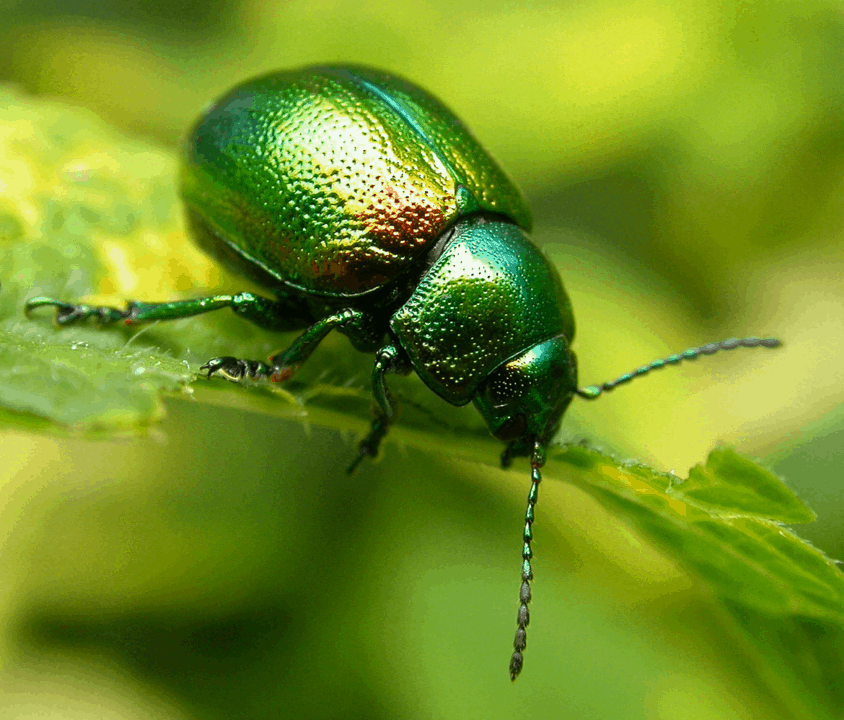
Nature of bug
Having a pet beetle might not seem normal in the west, but it’s a popular thing down in Japan. It’s so popular that dollar stores have them for sale. A beetle can be a tricky thing to take care of, as you can get them from the larvae stage and full-grown, each life stage needs different things. Also, different types of beetles have different needs that one should be aware of. So always make sure you know exactly what kind of beetle you are keeping as a pet.
Housing features
Normally, an adult beetle needs a plastic tank with around two inches of humid soil to walk on. You need a big enclosure for your beetle, as they love to move around. You should also leave a few twigs in it as well. You should put the enclosure under a light bulb, but make sure the entire cage isn’t heated by it, as sometimes beetles prefer colder places.
Feeding
A beetle diet can vary widely from each species. Beetles eat almost everything – from plants to other insects to small fishes and snails to even dung. Many common beetles will feed on fresh fruits. Those are very easy to feed – just make sure to give them a piece of any fruit once in a while.
Love and care
Beetles don’t live for long, usually three months. But you should be ready for a long relationship with beetles. Because they are social it’s better to have them in pairs (one male and one female) and they tend to reproduce rather quickly.
If you’re interested in keeping a ladybug as a pet, take a look at Can You Keep Ladybugs as Pets?
#9 Hissing Cockroaches

Nature of bug
Most people find cockroaches disgusting. But there is a select group of people that like them and decide to have one or more of them. Some even grow them as food.
Hissing roaches are your best bet when it comes to pet cockroaches. They don’t look like regular cockroaches and they are docile enough for humans to handle.
Housing features
Cockroaches are highly social, and you need to keep more than one if you want them to be happy.
A 15-gallon tank will house enough cockroaches for them to form a colony and live without stress. The enclosure needs to be sealed, as roaches will escape the moment they can. You should also keep in mind they will reproduce, and smaller roaches won’t hesitate to escape through little holes as well.
The cage should be in a warm place, as hissing cockroaches prefer heat. They also love to hide, and you should provide enough twigs and places for them to do it
Feeding
Hissing roaches need a diverse diet filled with greens (like veggies and fruits) and protein (like dry dog food).
You should provide water for your roaches soaked up in cotton, if you leave a small recipient filled with water it is likely the roaches will drown in it.
Love and care
Hissing cockroaches are some of the calmest cockroaches around. They can be picked up and you can gently pet them and examine them while in your hand. Of course, you don’t really have to do it if you find it scary – cockroaches are perfectly fine on their own and don’t really want human touch.
Beware a hissing cockroach is not the same thing as a regular cockroach. You should always opt for hissing roaches as pets. They are slow, docile, and are easy to care for.
#10 Millipedes
Nature of bug
Although they look like something straight out of a nightmare, millipedes can make great pets. And by examining them closely, you might even learn to not be scared or disgusted by them. Considering that millipedes are some of the oldest known land creatures and most of them are harmless, it’s definitely a good idea to get to know them better.
Fun fact: the first millipede that actually has more than 1000 legs was discovered only in 2020. It lives deep underground and it’s called Eumillipes persephone.
Housing features
Millipedes have similar needs to hissing cockroaches. They need a 10 to 15-gallon tank (or at least twice as long as an adult millipede) and they like a warm habitat.
You should also have three or four inches worth of soil to let them bury themselves in.
Feeding
You should leave two small recipients filled with water and food. Millipedes love decaying food, so leaving their food one or two days won’t bother them, but you should change their water daily. They mostly eat greens and fruit, cut into little pieces. If you want to keep your millipede as healthy as possible, you need to include calcium in their diet. The best way to do it is by powdering their food with a calcium supplement.
Love and care
Millipedes have a great lifespan, considering they are arthropods. If they are healthy enough, they can live up to a decade.
Millipedes have no problem living with one or more of their own. But if you decide to have them together, bear in mind millipedes will reproduce rather quickly.
#11 Centipedes
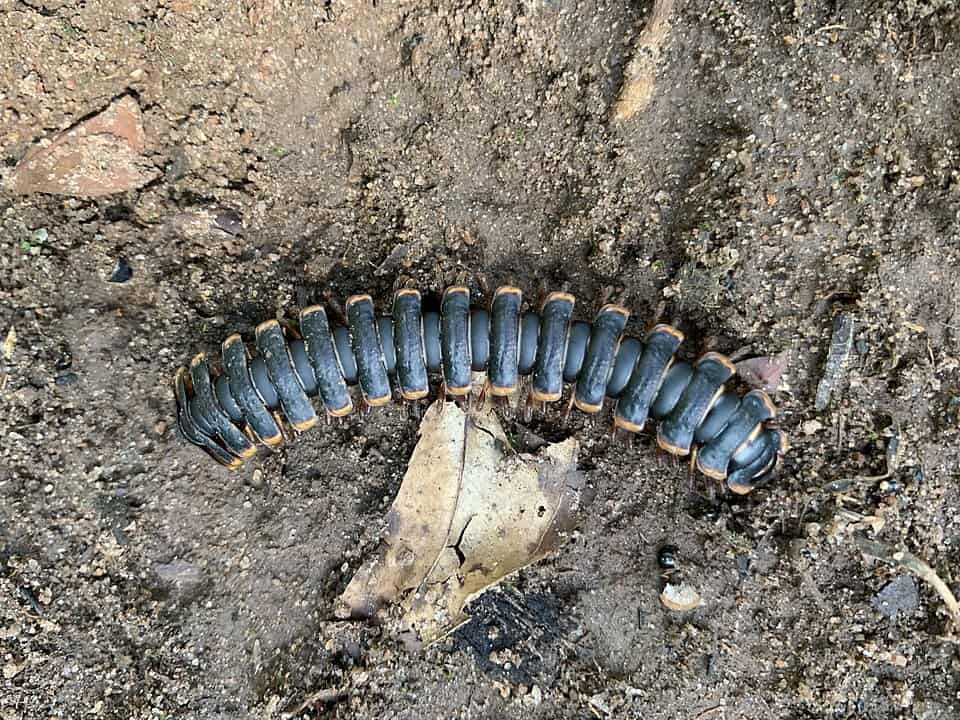
Nature of bug
Centipedes are similar to millipedes, but only in their looks. While millipedes are docile and easy-going, centipedes are the extreme opposite. They are carnivore arthropods who won’t hesitate to bite anyone who bothers them. They are also venomous, and they can affect humans, so choose carefully.
Housing features
A centipede’s enclosure needs are similar to those of a millipede. They need a big enough enclosure to wander around, twigs to have fun and hide, and a warm, humid environment. You should be extra careful with the enclosure’s lid, as centipedes tend to use their strength to open their tanks and escape.
Feeding
When it comes to eating, centipedes are completely different from millipedes, as they are carnivores. Centipedes feed off insects and you need to feed them small ants or crickets if you want them to live.
Love and care
You need to research and think long before you decide to adopt a centipede. They are aggressive and the hardest bug to foster. Their venom might not kill a human, but it can create a problem for us. And a centipede won’t hesitate to bite or poison their owner if they are angry enough.
#12 Scorpions
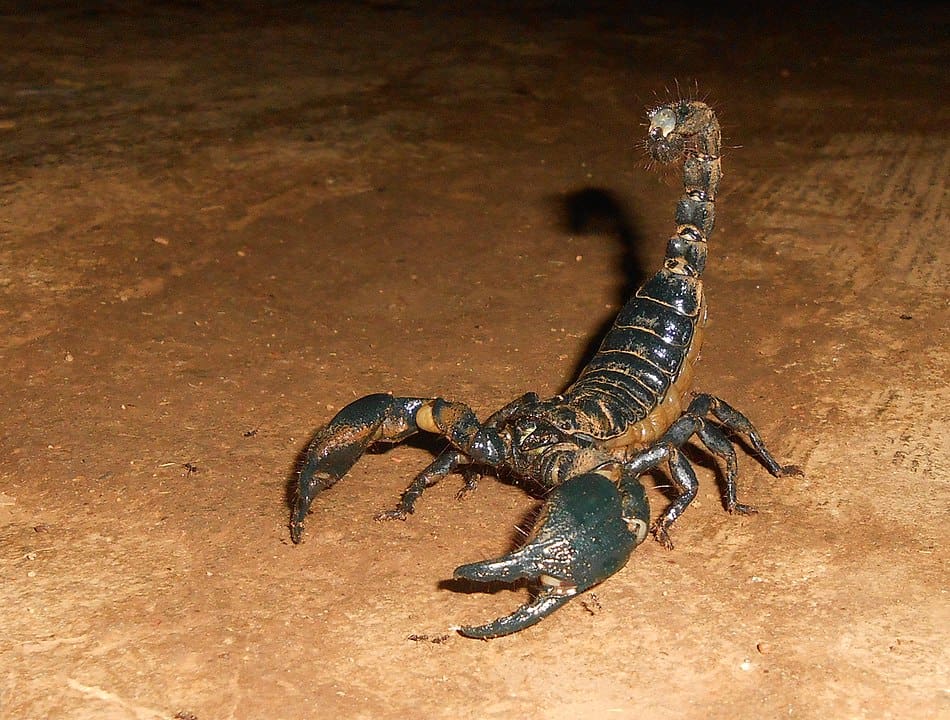
Nature of bug
If you want a challenging choice but centipedes are not for you, a scorpion might be a good fit. There are a lot of scorpions out there, and some are deadly for humans.
If you choose to have a pet scorpion, you need to ask your local veterinarian which one is available for you to foster.
Scorpions are also a long-term commitment, as they live from 6 to 8 years, sometimes more, depending on their species.
Housing features
You need a big enough cage for scorpions to wander around. Depending on where the scorpion is from, you might want to use soil, sand, or something else for the floor. The goal is to imitate the scorpion’s natural habitat.
Scorpions also need hiding spots in their cage. You can choose to have one scorpion or more. One scorpion needs a 10-gallon tank, and multiple scorpions might need a tank as big as 20 gallons. But no larger than that, as scorpions can have difficulty finding their prey in big enclosures.
Feeding
Scorpions share the centipede diet, as they are predatory arthropods as well. Crickets are a great choice to feed a scorpion, and they need one every one and a half-day, or six per week. A common issue with scorpions is dehydration, you need to constantly keep water in a shallow dish for it to drink. Avoid using any other dish as scorpions might drown.
Love and care
A scorpion isn’t a pet you can handle or touch. It’s for you to put in their cage and admire it from afar. Attempting to handle a scorpion might lead it to sting you or try to attack you with their claws.
#13 Mealworms
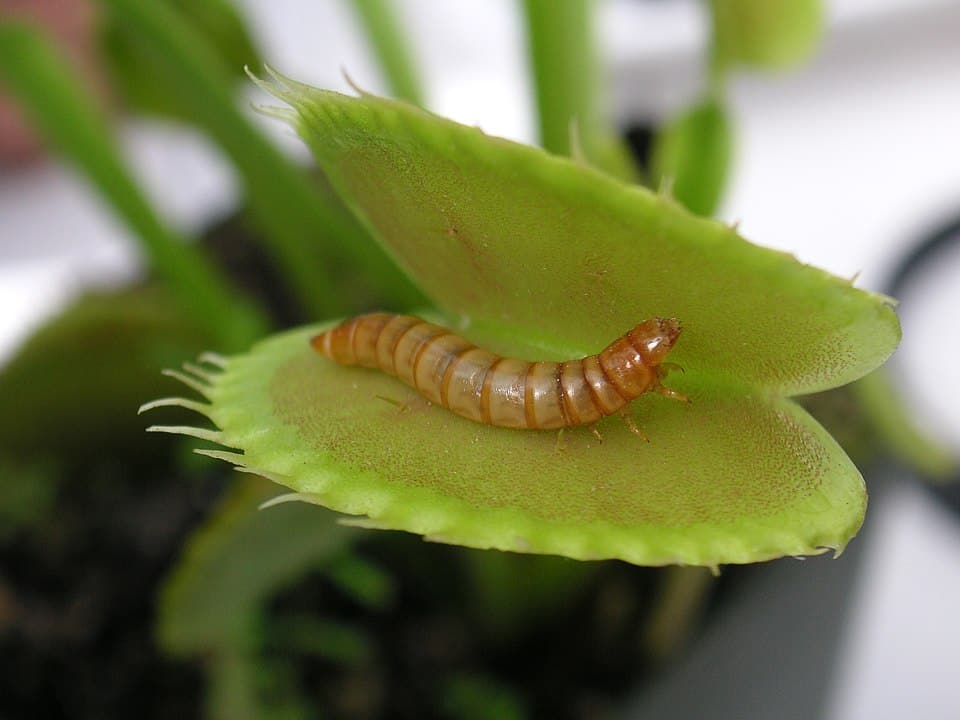
Nature of bug
Mealworms are probably the easiest pet bug to take care of. They don’t need much, they won’t attempt to escape and they won’t attack you, ever. They can be safely handled as they are not fragile, which makes them a great option for children.
Housing features
Mealworms are very easy to keep. All you need is a small plastic container with two inches of oats in the bottom of it. You can keep as many mealworms as you like, but if there is a lot of them make sure to choose a large enough container.
Feeding
On top of the oats, keep a shallow dish with water and another one with half a potato or a carrot for the mealworms to eat. Replace their food every couple of days or so, before it gets moldy.
Love and care
Mealworms don’t live for long, or rather, they turn into beetles after three weeks. The beetles will lay a couple of eggs and then will die as their lifecycle ends. If you buy a dozen mealworms and keep good care of their enclosure, you might find yourself with a colony quickly, where beetles lay their eggs, die and the larvae hatch as the cycle starts over.
#14 Ants
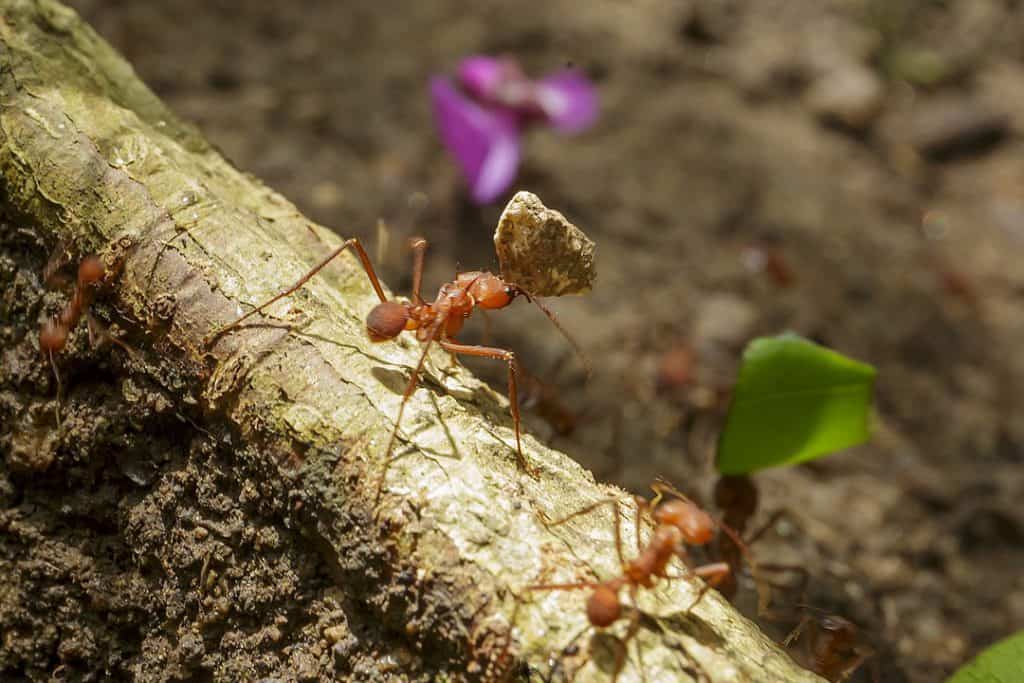
Nature of bugs
Keeping ants as a pet is considered by many as a hobby. It takes a lot of effort and can sometimes be an exhausting job. You might think it seems absurd as ants are rather small. But keep in mind you won’t have one ant but an ant colony. There is no one ant to choose, but rather different families of ants.
Housing features
According to the ant species you choose and what your goals are, you are going to get an ant farm (The ant colony’s cage) for all of them.
Feeding
When it comes to food, alive or dead insects are good for ants. They are going to need sugar water to handle their thirst. Depending on the type of ants you choose from, you might need to keep your ant farm moist or dry. Most ants thrive in a 20C environment.
Love and care
When it comes to ants, you can buy them from an expert or capture them from the wild. Your best option would be to talk to an expert, as he can guide you through any questions you may have about your soon-to-be hobby.
We have a whole article devoted to Ant Farms Gel vs Sand, Which is Best? if you’re thinking of starting up your own ant farm.
Final Thoughts
As you have seen, there are lots of bugs to choose from to keep as pets. And they make surprisingly great little companions for your home. You can choose which one you like the most and simply want to observe, but you might also want to pay attention to the maintenance they require.
For example, many carnivore bugs, like praying mantis, need to be fed live insects (yes, it’s absolutely necessary that they are still alive), and that might not be something anyone wants to do. For your first pet bug, you might want to choose a herbivore that’s easy to take care of, such as a stick insect. Those guys only need some leaves or berries and they’ll be happy!
In any case, I wish you the best of luck in finding your first pet insect.
If you enjoyed reading this article, why not check out our articles on Which Bugs are Attracted to Light? Let’s Find Out and Everything You Need to Know About Bugs and Pain
Recent Posts
Tiny Black Bugs in Bathroom NO WINGS: What They Are and What to Do!
Finding tiny black bugs in your bathroom can be uncomfortable, to say the least. Especially if they are persistent, or they appear in very large numbers, which they often like to do. When it...
Tiny Black Bugs in Plant Soil - What Are They & What To Do About It
A short horror story: You get a new houseplant. You do your best to take care of it. You’ve ensured that it has the right soil, the right amount of sun, it gets enough water. And then one day, you...

